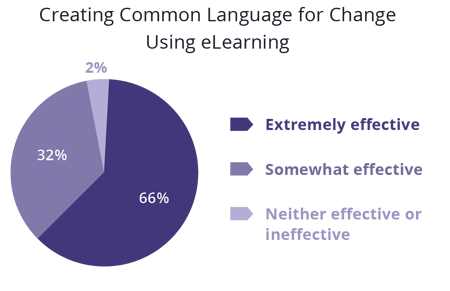Introducing a Common Language for Change Through eLearning

2 Mins
Updated: November 9, 2022
Published: November 14, 2018

Change initiatives often produce confusion and ambiguity for us as change practitioners as well as the people whose change journeys we're supporting. This ambiguity can inhibit progress of a change initiative.
However, there is something we can do to help smooth the path for change practitioners and the people being impacted by change: introduce a common language for change. Introducing a common language around change opens opportunities for more effective conversations and enables progress toward achieving outcomes. Let’s explore the value of having a common language for change and how to use eLearning to build it.
Want to learn more about how to build a common language for change with Prosci eLearning?
Value of a Common Language for Change
Having a common language for change offers numerous benefits. Prosci research reveals how organizations use the Prosci ADKAR Model as a common language for change, as well as the outcomes participants experience from using it. The benefits reported most frequently by research participants include:
- Improved project results
- Increased visibility for change management
- Change treated as process

According to one research participant whose organization uses the ADKAR Model as a common language for change:
“Impacted people have become more acceptant of change taking place. Sponsors have more confidence in communications and engagements and have more faith that adoption and utilization will take place within a shorter period of time than previous projects that did not include the ADKAR process.”
When asked why they use the ADKAR Model as their common language for change, participants report that the ADKAR Model:
- Offers an easy-to-explain and easy-to-understand framework
- Aligns with peoples’ natural experience and makes sense
- Provides common understanding and dialogue
- Articulates the change process
Another research participant reported:
“ADKAR has allowed us to more openly discuss change and manage change at all levels. It has prompted thought and caused more questions to be asked (a good thing) throughout the organization. Just for these reasons, we have increased our ability to deal with and adapt to change.”
Selecting a common language for change that utilizes words that everyone in the organization can relate to allows change to become something everyone can not only understand but positively influence. Using the ADKAR Model as a common language creates alignment on what change is from front-line employees to senior leaders.

How to Create a Common Language for Change
If establishing a common language for change can help achieve change outcomes and smooth lines of communication around change, how do you actually establish it? In today’s busy and dispersed organizations, building a shared language can be particularly difficult. That’s where virtual learning can help. Prosci offers four eLearning modules that include the ADKAR Model, so you can quickly bring people up to speed on the ADKAR Model vernacular in a way that relates to their role.
All of Prosci’s eLearning introduces the ADKAR Model in context. Many of the modules also prompt participants to create ADKAR Model profiles, which allow them to quickly identify and address their own barriers to change. Here are two ways you might use eLearning to create common language across the organization:
Level-set on the individual change process
The Introduction to ADKAR module is a great way to introduce the ADKAR Model as an individual change process to anyone in the organization, including project teams, key stakeholders, managers, and front-line employees. In this eLearning module, users apply the ADKAR Model to a change they are currently experiencing. This allows them to internalize what the ADKAR Model is and provides them with an opportunity to pinpoint where they are in the change process. The main outcomes include awareness of ADKAR as common language and tangible progress in their change journey.
Create common ground for managers and employees
You might build on the Introduction to ADKAR module by also having managers go through the Introduction to Leading Change module and their direct reports go through the Thriving Through Change module. Both modules put the ADKAR Model in the context of the participant’s role. By having managers and their employees go through these modules, you can enhance the common language for change used between them.
Creating a common language for change is one of the first steps you can take to creating alignment about what change is, smoothing communication around change, and fostering more productive conversations about change. How might you use eLearning to create common language?

